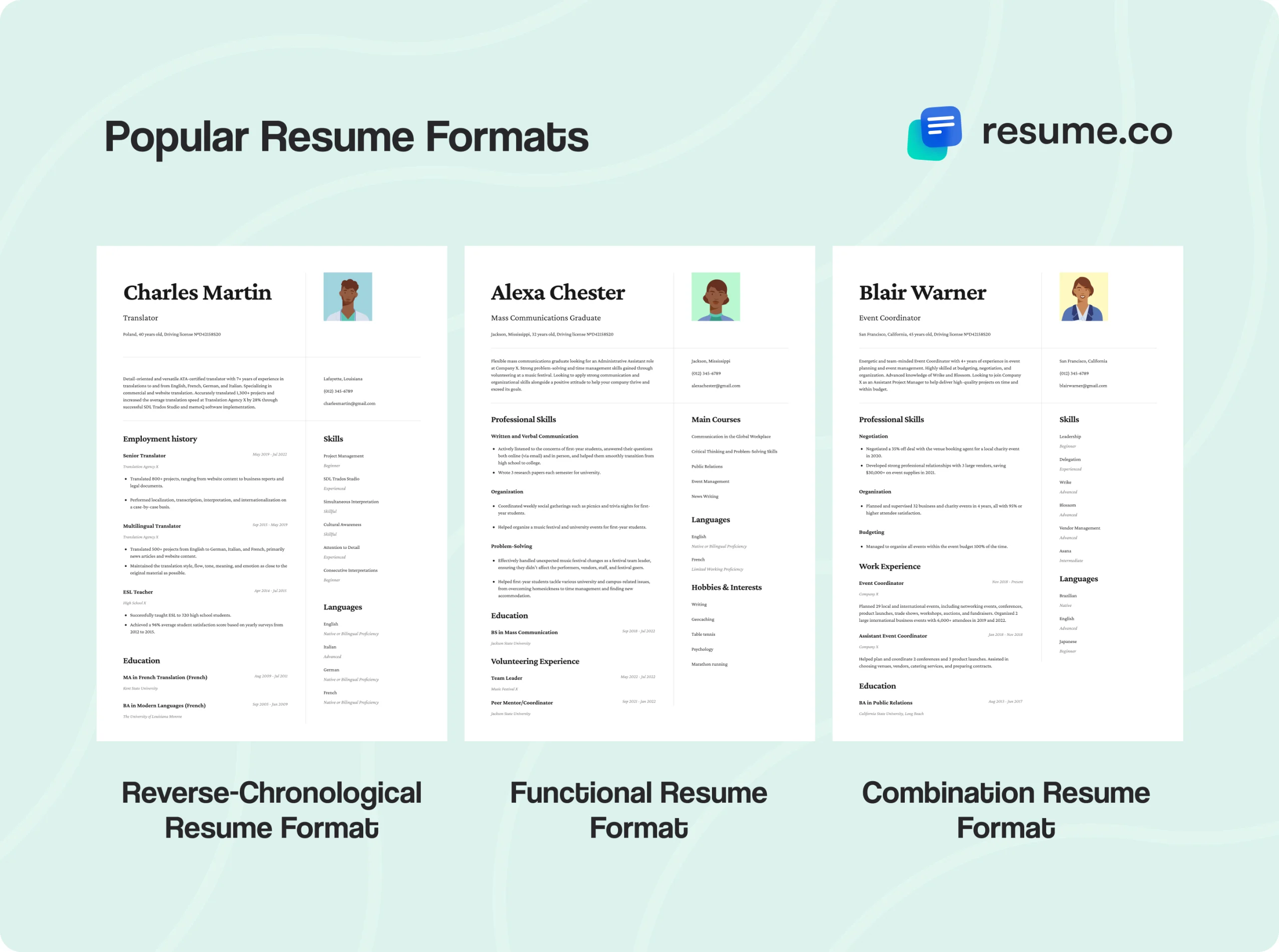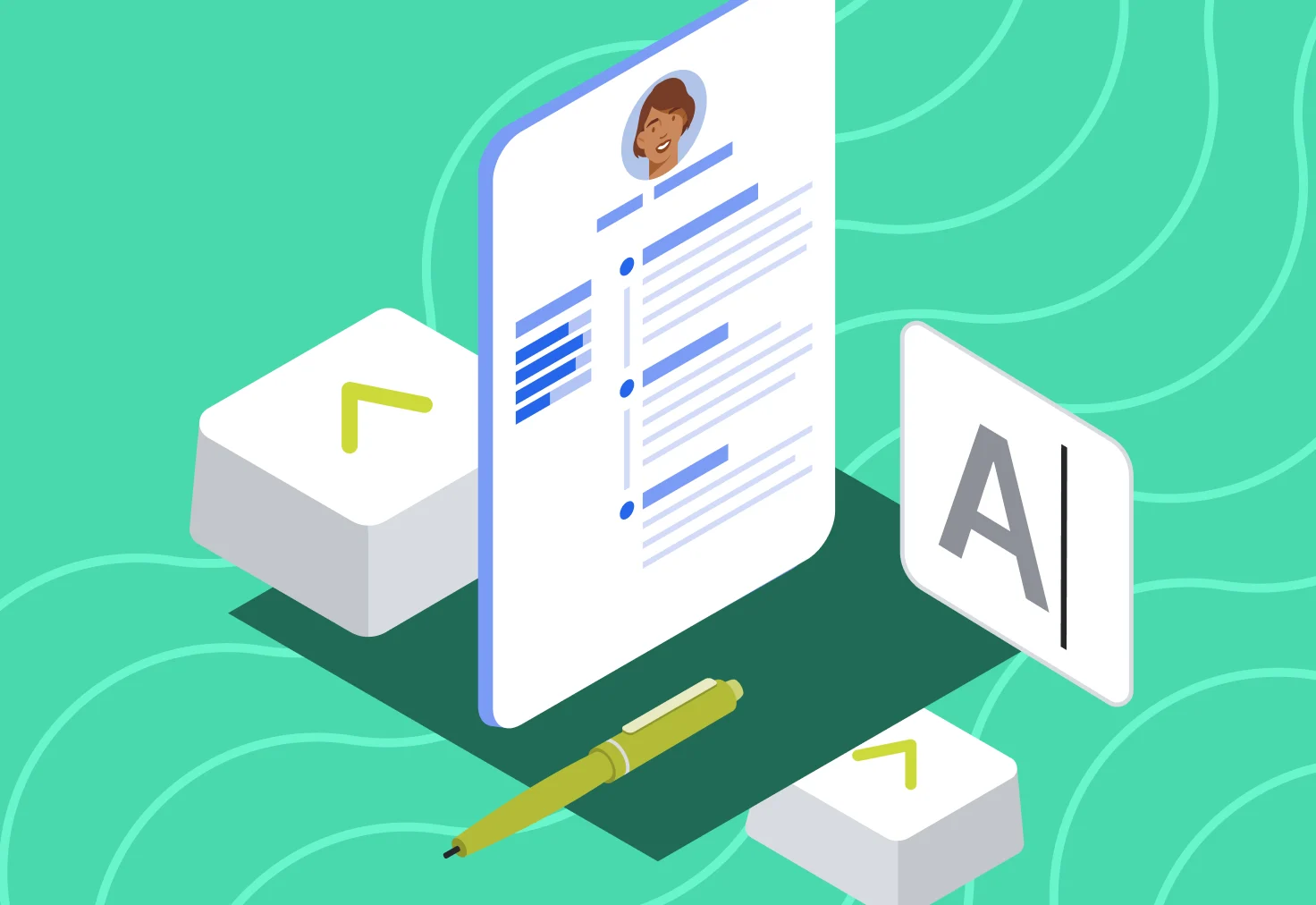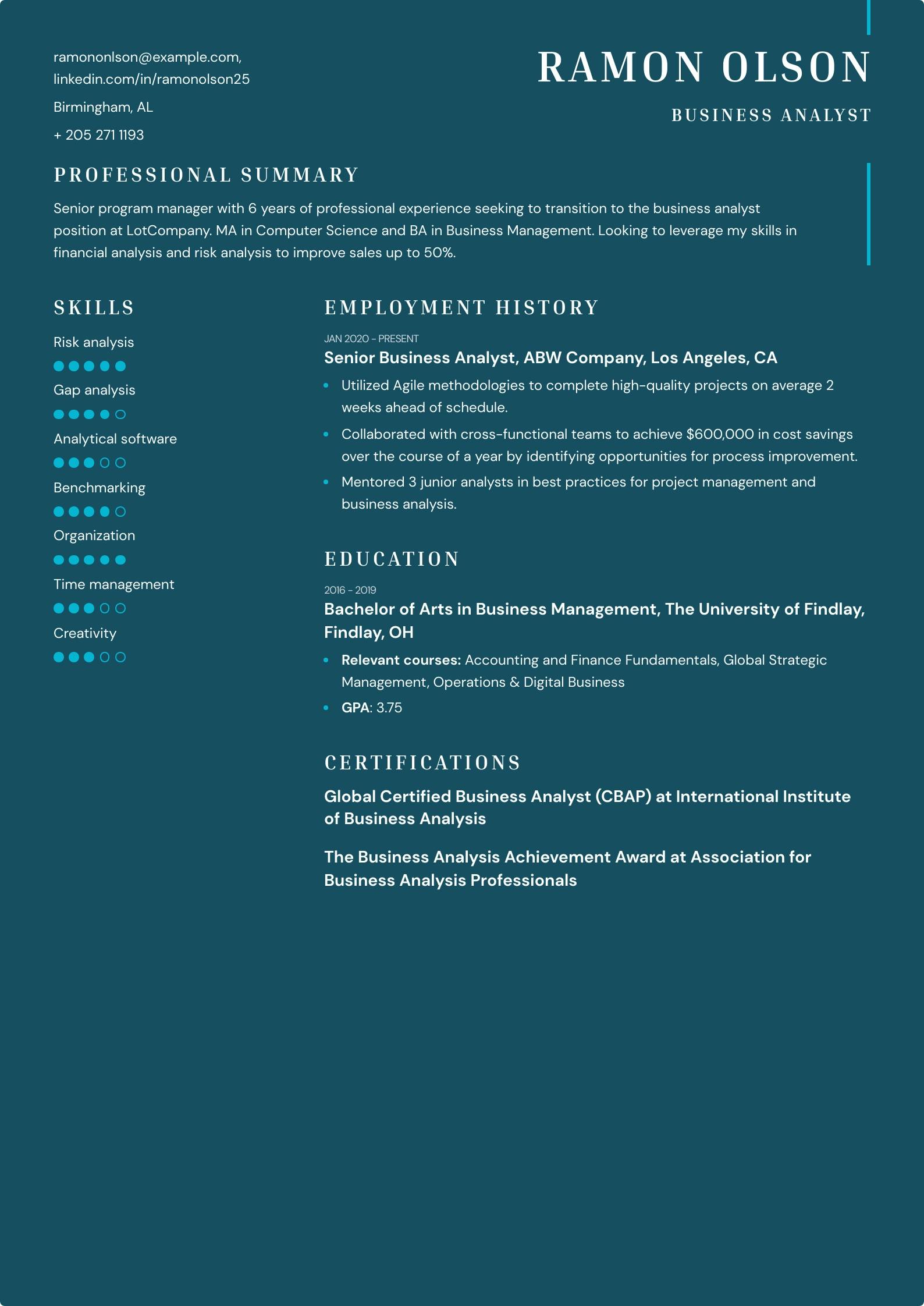Before you start searching for the role of a business analyst, you need to find the best way to convince potential employers that you’re able to make their business grow. To achieve this, you need to create a first-class professional business analyst resume.
Now, chances are you don’t know much about building a resume. Or, you have a general idea but need a couple of guidelines to help you tie it all together. If that’s the case, don't worry—we've put together a complete, easy-to-follow guide that you can use to make a business analyst resume from scratch.
Without further ado, let’s dive in!
Key Takeaways
The best and most common format for a business analyst resume is the reverse-chronological one.
Mandatory sections of your resume should include your contact information, a resume summary or objective, a list featuring the previous job titles you had, an education section, and a list of skills.
Optional sections are certifications, awards, languages, hobbies, and interests.
Writing and submitting a personalized cover letter is one of the easiest ways to get a head start on the competition and substantiate what you wrote in your resume.
What is the Right Format to Use for a Business Analyst Resume?

Creating an outstanding resume entails more than just including relevant information; it also entails proper organization and presentation.
If your business analyst resume is cluttered and hard to read, it won't help much even if you list all your impressive accomplishments and valuable skills. For this reason, you should start the resume-building process by choosing a proper resume format.
The most common and usually the best format for a business analyst resume is the reverse-chronological one. It focuses on the most recent job positions you held and lists the rest backward from there. This format is clean and organized, which is why recruiters around the world consider it the best option all-around.
If you’re new to the industry or you have employment gaps, you might want to focus more on your skills. In that case, consider a functional resume format, as this one helps you showcase your abilities even if you don’t have relevant work experience in the field.
On the other hand, seasoned veterans can take full advantage of a combination resume format. It’s a hybrid between the reverse-chronological and functional formats that helps candidates present their skills and illustrate them with some prominent professional achievements.
Resume templates
Resume templates that are designed to help you win a jobResume Layout
With the format out of the way, it’s time to adjust the resume layout. To make your resume look clean and convey information in an optimal way, consider the following guidelines:
Resume Layout Guidelines
Make sure your resume doesn’t exceed one page unless you have more than 10 years of experience and can’t fit all your accomplishments onto a single page. In that case, it’s acceptable to use a two-page resume.
Choose a suitable font for your resume. This means avoiding decorative, ornamental fonts and sticking to simple, sans-serif ones.
Don’t forget to set the right font size—10–12 pt for regular text and 14–16 pt for headers.
Have margins of at least 1 inch on all sides, and use line spacing of 1.0 or 1.15.
What Sections Should a Business Analyst Resume Contain?

Mandatory Resume Sections
Every business analyst resume must have the following sections:
Contact information
Resume objective or summary
Work history
Education
Skills
Optional Resume Sections
Additionally, including additional relevant information can help you stand out among the competition. To achieve that, consider some of these optional sections:
Certifications and awards
Languages
Hobbies and interests
Simply following these lists will ensure your resume has everything recruiters want to see.
However, if you don’t want to start from square one and keep tabs on everything, you can rely on our resume-building tool. It comes with pre-built templates that you can adjust and fill in with your information. Once you do it, you will have a professional business analyst resume within minutes!
Business Analyst Resume Template
Here’s a professional business analyst resume sample to show you what you can expect to find when using our resume builder.
Business Analyst Resume Template
Name and Surname
Phone number: 000-000-0000 | Email: namesurname@gmail.com | Location: City, State
[Adjective] [your job title] with [years of experience, if applicable] in [your area of expertise, if applicable] looking for a [position] job at [company name]. Eager to apply [relevant skills] gained through [work/volunteer/other experience] to help [company name] [mention what you can do for the company].
Skills Summary
Skill #1
Mention any achievements relevant to this skill
Explain how you used this skill
Explain how you used this skill
Skill #2
Mention any achievements relevant to this skill
Explain how you used this skill
Explain how you used this skill
Skill #3
Mention any achievements relevant to this skill
Explain how you used this skill
Explain how you used this skill
Work Experience
Most Recent Relevant Job Title Company City, State[Start date] — [End date]
For recent jobs, use 5-6 bullet points to list your top achievements and responsibilities
Use action verbs to make your responsibilities and achievements stand out
Add numbers to quantify your achievements
Less Recent Relevant Job Title Company City, State[Start date] — [End date]
For recent jobs, use 5-6 bullet points to list your top achievements and responsibilities
Use action verbs to make your responsibilities and achievements stand out
Add numbers to quantify your achievements
Education
[Degree] in [Major][University/college name][Start date] - [Graduation date]
Additional Sections
Add any relevant additional sections if you have space (soft and hard skills, languages, licenses, publications, etc.)
Business Analyst Resume Contact Information
Your contact information section goes in the header of your resume, as you want it to be clearly visible to recruiters. This part of your resume should feature your:
Name
Job title
Phone number
Professional email address
Optionally, you can also add:
Your address (city and state only)
LinkedIn profile
It’s best to use a professional job title and avoid experimenting with witty, sensational ones. Your job title acts as a keyword for the ATS, so you want it to match the one in the job description. Otherwise, your resume might get rejected by the software, which means it may never reach recruiters.
Now let’s put what we’ve learned into practice and see it in an example:
Contact Information Example
Ramon Olson
Business Analyst
+ 205 271 1193
ramononlson@example.com
Birmingham, AL
linkedin.com/in/ramonolson25
Business Analyst Resume Objective or Summary

You can’t rely on recruiters thoroughly examining your business analyst resume to see whether you’re a perfect candidate. They typically spend less than 10 seconds skimming through resumes due to a lack of time, which is why you need to start yours with a short elevator pitch in the form of a resume objective or summary.
A resume objective should be positioned at the top of the document and consist of several short sentences that present you as an ideal candidate for the position you’re applying for. You should use it to state your future professional goals and explain how you can benefit the company. It’s typically used by applicants who have little to no work experience.
On the other hand, a resume summary has the same purpose as a resume objective and looks similar, but it’s reserved for people who have some professional experience under their belt. It should feature some of the career achievements you’re most proud of and show hiring managers what you can offer to the company.
Entry-Level Business Analyst Resume Objective
If you’re an entry-level candidate for the business analyst job position, you should strive to show your potential since you don’t have an extensive work history. You’ll have recruiters’ attention if you describe your professional goals and show that you’re willing to learn and improve.
Check out this good example:
Good Example
“Motivated business analyst with a BA in business management and relevant coursework. Internship experience analyzing service and product lines. Looking to become a part of a cross-functional team at [your company] to help reach more clients and maximize revenue.”
For comparison, let’s take a look at a bad example:
Bad Example
“Recent graduate looking for an entry-level position as a business analyst to learn and improve my skills.”
Being eager to grow is always a good trait, but you need to show that you already bring something to the table. Employers are always willing to invest time and resources in candidates with potential, which is what you need to display.
Business Analyst Resume Objective
Another reason to write a business analyst resume objective is a career change. Talk about where you are at the moment and where you’re going, and show what your future employers can expect from you.
Check out a good example:
Good Example
“Senior program manager with 6 years of professional experience seeking to transition to the business analyst position at [company name]. MA in Computer Science and BA in Business Management. Looking to leverage my skills in financial analysis and risk analysis to improve sales up to 50%.”
Now here’s a bad example:
Bad Example
“Experienced program manager looking for a position of a business analyst. Eager to take on a new role and further polish my skills.”
With no concrete information about the candidate’s skills and competence, the recruiters can only guess what they are capable of.
Business Analyst Summary
A resume summary differs from the objective, as it aims to highlight the candidate’s most prominent professional achievements. Its goal is to summarize the resume and grab hiring managers’ attention with a short preview of the most impactful bits.
Here’s a good example:
Good Example
“Senior business analyst with 7+ years of experience in the field. Most notable achievements include increasing the company’s revenue by $15M by analyzing data involving workflows, customer behavior, and stakeholder goals. Looking to leverage my skills in research, optimization, and analytics to improve business at [your company].”
And now, a bad example:
Bad Example
“Skilled business analyst with years of experience looking to use my abilities to help your company reach its goals and improve its business.”
This sounds more like a resume objective of a candidate who doesn’t have much professional experience.
Business Analyst Resume Work Experience
Recruiters often check out your work experience section first and spend the most time reading that part. It gives them direct insight into your proficiency, which is why this section is usually the fundamental part of your resume.
General Tips
Luckily, it's not too hard to make a captivating work experience section for your business analyst resume if you follow these tips:
Make sure to include the following information for each separate job position you list in this section:
Title
Company name and location
Start and end dates of employment
Significant responsibilities and achievements within the role
Focus more on the accomplishments achieved and results obtained than on your responsibilities.
Use bullet-point lists instead of blocks of text to convey more information in a readable and professional manner.
To make your achievements more prominent, use numbers and percentages. They’ll quantify your results, making them concrete in the eyes of hiring managers.
Furthermore, including some extraordinary action verbs and power words will help you stand out among the competition. Where most candidates use “worked” or “managed,” try using “spearheaded” or “conceptualized” instead.
Business Analyst With No Experience

We talked in great detail about how work history is one of the most important parts of your business analyst resume. So, what happens when you have little to no professional experience to showcase? The answer is—you can include other similar activities in your resume to make up for it, including college projects, freelance and volunteer work, internships, etc.
Let’s see that in an example:
Business Analyst With No Experience Example
Work Experience
Business Operations Analyst Intern
XYZ Networks New York, NY
June 2022–October 2022
Assisted in maintaining 20+ databases for a team of executives.
Conceptualized 10+ new business applications and oversaw their design, development, integration, and testing.
Participated in 7 reviews to ensure the company’s solutions complied with standards and guidelines.
Experienced Business Analyst

As a veteran in the field, you want to put your best foot forward and highlight your most impressive professional accomplishments. Show impactful results through 3–5 bullet points per job, but don’t clutter the section and list every achievement that comes to mind. That could weaken the overall effect this part of your resume has on your future employers.
For the same reason, don’t include irrelevant or outdated jobs. You can include more than one previous employment in reverse-chronological order, but make sure they are highly related to the position you’re applying for.
Here’s an example:
Experienced Business Analyst Resume Example
Work Experience
Senior Business Analyst
ABC Company Los Angeles, CA
January 2020–Current
Utilized Agile methodologies to complete high-quality projects on average 2 weeks ahead of schedule.
Collaborated with cross-functional teams to achieve $600,000 in cost savings over the course of a year by identifying opportunities for process improvement.
Mentored 3 junior analysts in best practices for project management and business analysis.
Business Analyst Resume Education Section

Adding education history to your business analyst resume is usually as simple as it gets. All you need to do is disclose the following details for each degree you want to add:
Education Section Essentials
Degree type and major
School/institution name
Years of attendance
Relevant coursework, impressive achievements, and more
Here’s what that looks like in practice:
Education Section Example
Education
Bachelor of Arts in Business Management
The University of Findlay, Findlay, OH
2016–2019
Relevant courses: Accounting and Finance Fundamentals, Global Strategic Management, Operations & Digital Business
GPA: 3.75
If you have a long and comprehensive work history, make your education section brief. But if you’re new in the industry, you should put more emphasis on academic achievements and even list multiple degrees in reverse-chronological order. If you have a BA or a higher degree, you don’t need to mention your high school education.
Business Analyst Resume Skills

Anyone can create a list of skills for a business analyst resume, but it takes a bit of nuance to add them to your document properly.
For starters, you want to analyze the job description before writing a business analyst resume to figure out exactly which skills recruiters are looking for the most. Then, create a separate section after the education one on your resume and list soft skills and hard skills separately because they are vastly different.
Hard skills are specific to your line of work. They are usually obtained through formal education, and you’ll have various degrees and certifications to prove them. Recruiters will be most interested in these skills, as they allow you to do the job in the first place.
Once you include them in your resume, you should add a select number of the most sought-after soft skills to it as well. Soft skills are personal attributes and qualities that enable you to effectively interact with others. They are more general than hard skills, can be used in different jobs, and are usually learned through real-world experience.
While soft skills are incredibly valuable, they are much harder to prove and should be used to supplement your hard skills.
Hard Skills for a Business Analyst
Here are some of the hard skills you could include in your business analyst resume:
Risk analysis
Financial analysis
Gap analysis
As-in analysis
Analytical software
Wireframing
Benchmarking
Soft Skills for a Business Analyst
Some of the soft skills that recruiters look for the most are:
Organization
Attention to detail
Time management
Teamwork
Communication
Creativity
Adaptability
Business Analyst Resume Optional Sections

If you want to leave a lasting impression on hiring managers, you should consider adding some optional sections to your business analyst resume. As long as there’s room left after you’ve included all of the mandatory ones, they will help you show that you are ready to go above and beyond for business.
Certifications & Awards
Certifications show specialized knowledge and add credibility to your skills and education. On the other hand, awards are recognition for outstanding performance and commitment to business. Both of these deserve a spot on your resume. Add them after the mandatory sections, like in the following example:
Certifications & Awards Example
Awards & Certifications
“Global Certified Business Analyst (CBAP)” - International Institute of Business Analysis (IIBA)
“The Business Analysis Achievement Award” - Association for Business Analysis Professionals (ABAP)
Languages
Proficiency in foreign languages is always a welcome addition to your resume. You likely won’t be required to use another language in a workplace, though a job posting might make this section a requirement in certain cases.
Keep this section brief and rank languages by proficiency, using one of the following levels for each language listed:
Language Proficiency Description
Native
Fluent
Proficient
Intermediate
Beginner
Hobbies & Interests
This section has nothing to do with the work of business analysis, but it can end up being the one that sets you apart from the other candidates. It shows who you are as a person and paints a picture of an interesting individual with drive and passion.
Place this section at the bottom of your resume, keep it brief, and don’t be afraid to include something completely unrelated to work as long as you’re truly enthusiastic about it. Lastly, be prepared to talk about your hobbies and interests once you land a business analyst interview.
Expert Tips for Creating a Business Analyst Resume
If you’ve followed all the steps so far, your business analyst resume will be all but finished. Here are a few expert tips to help you polish your document:
The maximum length of your resume should be one page, with a clear structure and proper formatting.
In addition to having a dedication section for your skills, you should also mention the most important ones in your resume summary or objective and your work experience section. Use those opportunities to back up these abilities with relevant accomplishments in your career.
Proofread your resume to make sure there aren’t any mistakes. Ask a friend to help you and look at it with a fresh pair of eyes.
It is generally easier to write a resume summary or objective after you’ve finished all the other sections.
Use a business analyst cover letter to complement your resume. Don’t just repeat the same information, but mention skills, achievements, and results that didn’t fit onto your resume.
Closing Thoughts
And that’s it! Create a resume by following this guide, and you’ll be preparing for an interview in no time. Also, remember that you can speed things up by using our resume builder. No matter which option you go with, you’ll be well on your way to landing your dream job. We wish you the best of luck on that journey!
Related Articles
Business Resume Example & Writing Guide


